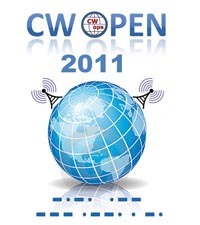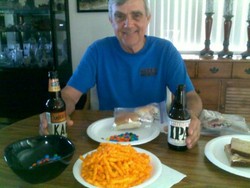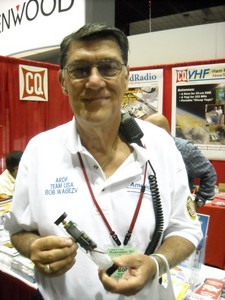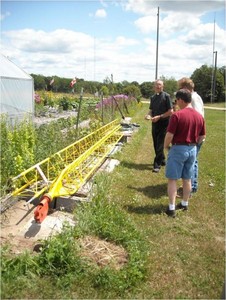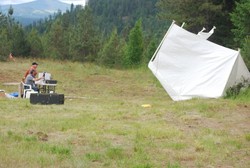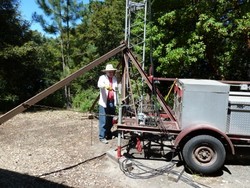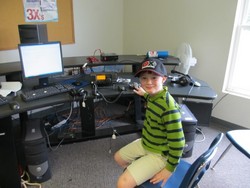 July 20, 2011 Editor: Ward Silver, NØAX | ||||||||
IN THIS ISSUE
NEW HF OPERATORS - THINGS TO DO There are some interesting contests of the few in the next two weekends - if you like chasing island contacts, the IOTA Contest is a lot of fun. County hunters and mobile ops can be found roaming the land in the MARAC QSO Party. And what are the "bumblebees" swarming around the QRP CW calling frequencies? Portable stations operating with low power in remote spots - buzz up the band and bag a bunch! BULLETINS There are no bulletins in this issue but your editor is going to be taking a vacation and so the following issue will be somewhat attenuated. BUSTED QSOS My reference to "Bavaria" in the previous issue was not to the German state but to the general region - apologies to the inhabitants of the state of Baden-Württemburg who are justifiably proud of hosting the Friedrichshafen hamfest. Also, Mitch DJØQN and photographer Bob W5OV note that the Alps in the photo behind the ferry are Swiss. CONTEST SUMMARY Complete information for all contests follows the Conversation section July 23-24
July 30-31
If you haven't put this one on your calendar yet, now is the time. Sponsored by the CWops group, the new CW Open (CWO) contest (Aug 20-21) is unique - a package of three, 4-hour contests during a 24-hour cycle with separate scores and awards for each. The idea is to try for fairly similar conditions in all three ITU regions over that cycle during at least two of the three events. Of course, it will not necessarily be the same two events in each region. The scoring is also unique - 1 point per QSO per band; 1 mult the first time you work that call sign. In other words, this contest is about working a lot of different participants rather than working a smaller fraction on multiple bands. As such, it gives hams with modest rigs and wire antennas a chance to rack up decent scores. Theoretically, a 100-watt station on a single band could come in on top in one of the sessions. Team competition is also a part of the contest. There is already a tested module on N1MM for CWO; one nearing completion for WriteLog; and completed (but not fully tested) modules for CQ/X, GenLog and SD. (Thanks, Rob K6RB and Al AD6E) Win-Test maven Bob N6TV has created the AltDScripts3 package of configuration scripts for the program to implement the Enter-Sends-Mode TR-LOG style of SO2R operating. The July/August, 2011 issue of the National Contest Journal (NCJ) contains an article written by top contester Scott KØDQ, documenting his migration from TRlog to Win-Test, using a DX Doubler and PIEXX SO2Rxlat box for SO2R control. The NCJ website's Bonus Content also includes a PDF file titled "Downloading and Setting Up WINTEST for SO2R". with detailed screen shots and set-up instructions. You can turn your smartphone into an ISS visible pass predictor for iPhone and Android operating systems. Web based predictions are also available using the Simple Satellite Tracker on the Spaceweather web site. (Thanks, AMSAT bulletin ANS-191)
Here's something new and interesting from Zone 34 - the second issue of The Egyptian Radio Amateur Magazine "CQ EGYPT" for July 2011 is online. A couple of the articles are in English and perhaps future issues will have both Arabic and English translations. Let's hope this is a trend toward more activity from the Middle East as government restrictions are relaxed! Web Site of the Week - You think you have QRN? The Cassini space probe, in orbit around Saturn, has been monitoring the enormous "white spot" storm since late last year. The noise was so impressive that NASA felt obligated to post a recording of it. Maybe they could use a little DSP in their radios! I don't think we're going to work Saturn on the low bands any time soon. WORD TO THE WISE Haboob - Phoenix, Arizona residents are currently experiencing another of these intense sandstorms more often associated with the Sahara and Frank Herbert's novel Dune. As all fans of the original Star Trek series know, a sand storm can be turned to useful purposes...why not hang that corroded aluminum outside and let the haboob take care of scouring it? The AMSAT weekly bulletin ANS-191 had several good video links such as the news item about the new United Launch Alliance's launch complex. You can take a complete level-by-level tour online! Not to be outdone, the Goddard Space Flight Center has released a video (with sound) so you can experience first-hand a ride aboard a sounding rocket.
Now here's a rover we'd all like to see spun off from the space program - the NASA Curiosity would look good with some VHF+ antennas on it, wouldn't it? I particularly like the idea of a laser that can vaporize rocks at seven meters. Surely there is an amplifier-worthy power supply in there somewhere! To be launched later this year, Curiosity is scheduled to touch down on Mars in August of 2012 near Gale Crater. Results for the 2011 ARRL DX CW Contest are now online on the ARRL Contest Branch webpage. Look for the DX Phone article before the next newsletter issue is released! (Thanks, ARRL Contest Branch Manager, Sean KX9X) CQ WPX Contest Manager, Randy K5ZD wants to let us all know that the raw claimed scores for the 2011 WPX CW Contest are now online. The page includes a search function so you can quickly locate a particular score or you can browse scores by continent and category. Results of the Ukrainian DIGIFEST 2011 (held just a few weeks ago on June 4 and 5) are online. Serge UX1UA reports that participation almost tripled and the number of logs received exceeded 200. (Thanks, Yuri VE3DZ) OPERATING TIP Symmetry - if you are giving SO2R a try, make it easy on your poor, overloaded brain by arranging the switching and computer display so that switches and windows "follow" the layout of the station. If Radio 1 is physically on the left, make switches turn to the left to select Radio 1 and place windows with information about Radio 1 on the left of the display. You'd be surprised at how much that helps a tired operator in the middle of the night!
Heavy masts can be difficult enough to wrangle on the ground and even more-so at the top of a tower where your leverage is severely limited. How should you raise a mast to its final position? Assuming you've lifted the mast to the top of the tower and it's in the sleeve or thrust bearing, a gin pole often runs out of steam at this point. Stan K5GO suggests this approach - "I have always used a come-a-long attached to the top rung of the tower and a muffler clamp around the mast (as the lift point - Ed.), wrapping the cable with the hook around the mast below the clamp. Loosen the bearing so it will slide through and have a short 2x 8 board handy to rest the mast on to reposition the clamp to go higher." Roger K8RI suggests a variation on this theme to increase the mechanical advantage. He attaches a pulley to the mast and runs the come-along cable back up to another rung on the tower. This makes for a more symmetrical lifting force on the mast and reduces tower rung loading. Phillystran non-conductive guy line is marvelous stuff but it is not as hard as steel. This can be a problem when using ceramic insulators to join Phillystran to EHS steel guy wire. Tim K3LR fills us in on the right way to do things - use a metal Preform Guy Grip made for Phillystran to connect to the ceramic insulator. The hard ceramic with the tight-radius bend can over-stress Phillystran (guy wires have minimum radius specifications for bends, too) and the sharp ridges often present in molded ceramic insulators will cut through Phillystran and rope, too. The rule is to have metal on ceramic whenever a load-bearing line is attached to an insulator.
The shipping costs for steel push-up masts can be fierce - more than the cost of the mast! This is at least partly because the masts are too long for standard parcel services. At least one solution exists in the form of the Rohn 9H50 - a If you are trying to match the special paint on an old radio, Glen K9STH may have the solution. Go to a paint store and have the paint "computer matched". He uses acrylic paint that runs under $13 for a quart, there is no charge for the matching, and a number of attempts have all been "spot on". Weed whacker line can be used to space air-wound coils for mobile antennas, traps, loading inductors and so forth. It comes in a number of diameters similar to copper wire and since it is non-conductive, once you're done winding you can leave it in place to keep the windings from moving. (Thanks, Mark KA6WKE)
From the July edition of Analog Device's Analog Dialogue features the article "Differential Interfaces Improve Performance in RF Transceiver Designs" discussing the problems of single-ended interfaces at RF. Good reading for the digital radio designer. Don't turn the fan - turn the heat sink! I guess you would have to use slip rings to get signals into and out of the amplifier and "balanced feed line" takes on a whole new meaning! The Air Bearing Heat Exchanger invented at Sandia Labs is definitely an out-of-the-box solution to a ham's age-old cooling problem. If you haven't checked out the Force 12 Loop-Fed Antennas, this might be a good opportunity to do so. Not a Quagi-style antenna, the VHF/UHF LFA uses a loop for the driven element, but in the same plane as the directors and reflectors. The same web page describes an OWL - the Optimized Wide-band Low-Impedance Yagi. Both antennas are designed for 50-ohm feed point impedance and direct-connection of the feed line. Technical Web Site of the Week - If you want to get your kids interested in electricity, why not use this Playdough-based approach? No word on whether the circuits will taste good and salty like the...oh, sorry Mom. How To Have A (Contest) Conversation After the last issue was emailed to readers, I received a most reasonable request. "This issue shows how NOT to make a Field Day QSO. How SHOULD I make a Field Day QSO?" Here is a good example of how experienced operators (i.e. - your editor) can forget that criticism without instruction is not helpful. One has to demonstrate the right technique so as to illustrate why the wrong technique is, in fact, wrong! So here goes...
First, a disclaimer. There is no One Perfect Method for efficient, effective contest operating. The "right" technique depends on band conditions, how many are (or aren't) calling, the intensity of the competition, and the skill of the operators on each end. What follows are guidelines and I am assuming that the contest is a phone contest. The reader should be able to apply the same principles to CW and digital contest operation. To make a lot of QSOs in a fixed period - the goal of nearly every contest - you need to minimize the time you spend making each QSO. The first step in minimizing the duration of a QSO is to remove all unnecessary verbiage. In a perfect world, the only thing you should hear going back and forth during a contest is call signs and exchange information. It should sound like this: 1 - CQ Field Day KOØA 2 - [pileup] 3 - W1ABC 2 Alpha Missouri 4 - 1 Alpha Eastern Massachusetts 5 - Thanks KOØA Not a wasted bit of transmitting exists in that exchange. Lines 1 and 5 are "bookends" in which KOØA identifies and solicits QSOs. (This style of operation is sufficient for W1ABC, as well.) This is the standard to which you should aspire on either end of the QSO. In Line 3, KOØA has pulled out a full call sign from the pileup, sent it to notify everyone who the QSO is with, given the information in the expected order and stopped transmitting. KOØA does not say, "Please copy..." or "You are..." or repeat any information or say, "Over" or "Go ahead" or any number of other things that take up time but don't add anything to the flow of the contact. In Line 4, W1ABC responds when called, gives the contest information, and stops transmitting. That's it - no extra "stuff" to slow things down. In Line 5, KOØA acknowledges that the information was complete and the call sign ends the transmission. No "QRZed" or "CQ Field Day" or "from" is required. If no stations call, then a longer CQ transmission starts the cycle again. (A nit to pick...when a station says "You are" and then describes their own configuration, shouldn't that really be "I am"?) When should you deviate from this ideal? There are lots of reasons to do so. In Line 3, KOØA should not give out any exchange information until sure of enough of the caller's call sign that only one station is likely to respond. For example, if KOØA doesn't get the last letter of W1ABC's call..."W1AB-something 2 Alpha Missouri, what's the last letter?" W1ABC should respond with something like, "W1 Alpha Bravo Charlie, last letter is Charlie, 1 Alpha...etc" Why does W1ABC repeat the full call? To confirm that the missing letter is the last one and that the call is not W1CAB or just W1AB. Similarly, if KOØA has W1ABC's call wrong, W1ABC might simply respond with, "W1ABC". At that point, KOØA can resume with Line 3 shown above. What about repeating your information? If not requested to do so, don't! 9 times out of 10, even a QRP station will be perfectly readable in Line 4 above. The other callers are standing by (hopefully) so KOØA is probably going to get the information on the first transmission - don't waste time with unrequested repeats! If a repeat is requested, repeat only the information requested. Should W1ABC give KOØA's call sign in Line 4? Whenever there is any question about the intended receiving station give the call sign. It is very common under crowded contest conditions for two stations to be extremely close together or even on the same frequency if they are in each other's skip zones or have antenna nulls aimed at each other. When this happens, don't depend on timing - give the other station's call sign before sending your own information. If you don't, you take a chance that the "wrong" station will log you. The extra information often saves losing a contact (and the multiplier and the possible penalty). What if W1ABC misses some of KOØA's information? Then W1ABC should request a repeat ("What is your section?") BEFORE proceeding with "1 Alpha Eastern Massachusetts." W1ABC should not transmit any exchange information until all of KOØA's information has been received. If W1ABC waits until after sending the category and section to ask for a repeat, KOØA will likely assume W1ABC received the information OK and will proceed with Line 5 too soon. This gets everything out of sync for everybody, including any callers waiting to contact KOØA. Yes, W1ABC could wait until KOØA's next contact to copy the information but I can tell you from personal experience - it doesn't always work out that way! Get the information you need during the contact and don't assume you can get it on subsequent contacts - that's a big waste of time for you. Obviously, there are many more variations on the basic theme. By practicing, you'll learn the basic principles of snappy, crisp operating. To learn more about effective, efficient operating, listen to the top operators on the air while they are "running" and try to emulate them.
The top operators are flexible, too. When conditions require it, they will "change gears" to a faster or slower technique in order to maintain the flow of information and keep the contacts coming. Just like a long-distance runner who only lifts each foot enough to clear the ground, the top operators only transmit enough information to keep making contacts. You might not think the difference between "Thanks" and "Thank you" is worth much, but if in a 48-hour contest the goal is upwards of 5000 contacts, saying the extra "you" 5000 times is significant. This may be "cutting the tags off the teabags" as the backpackers say but work on eliminating non-essential transmissions and see if your log doesn't fill up a little quicker! Should this be the style of operating for casual, non-contest contacts? Of course not! But it would be completely appropriate for a net control station trying to run an emcomm net with many calling to check in, pass traffic, report status, etc. When trying to handle that load "extra stuff" can really gum up the works. The habits and skills formed under contest conditions help make you an effective operator when the chips are really down - in a disaster or emergency situation when every minute counts. 20 July through 2 August An expanded, downloadable version of QST's Contest Corral in PDF format is available. Check the sponsor's Web site for information on operating time restrictions and other instructions. HF CONTESTS NAQCC Monthly QRP Sprint--CW, from Jul 21, 0030Z to Jul 21, 0230Z. Bands (MHz): 3.5-14. Monthly on 2nd Tuesday or 3rd Wednesday (alternating). Exchange: RST, S/P/C, and NAQCC mbr nr or power. Logs due: 4 days. Rules Flight of the Bumblebees--CW, from Jul 24, 1700Z to Jul 24, 2100Z. Bands (MHz): 7-28. Exchange: RST, S/P/C, Bumblebee nr or power. Logs due: 8 days. Rules MARAC US Counties QSO Party--Phone, CW, from Jul 30, 1200Z to Jul 30, 0600Z and Jul 31, 1200Z to , 2359Z Jul 31, Multiple operating periods;. Bands (MHz): 3.5-28, 50-144, Frequencies: CW - 50 kHz above band edge; SSB - 1.85, 3.85, 7.25, 14.27, 21.4, 28.4, 50.135, 146.53. Exchange: RS(T), state, county abbreviation. Logs due: May 31. Rules IOTA Contest--Phone, CW, from Jul 30, 1200Z to Jul 31, 1200Z. Bands (MHz): 3.5-28. Exchange: RS(T), serial, IOTA number if island. Logs due: 3 weeks. Rules VHF+ CONTESTS 144 MHz Digital EME Championship--Digital, from Jul 30, 0000Z to Jul 31, 2400Z. Bands (MHz): 144. Exchange: TMO or RST and R. Logs due: Aug 8. Rules MARAC US Counties QSO Party--Phone, CW, from Jul 30, 1200Z to Jul 30, 0600Z and Jul 31, 1200Z to , 2359Z Jul 31, Multiple operating periods;. Bands (MHz): 3.5-28, 50-144, Frequencies: CW - 50 kHz above band edge; SSB - 1.85, 3.85, 7.25, 14.27, 21.4, 28.4, 50.135, 146.53. Exchange: RS(T), state, county abbreviation. Logs due: May 31. Rules LOG DUE DATES 20 July through 2 August July 20, 2011 West Virginia QSO Party July 20, 2011 RSGB 80m Club Championship, SSB July 24, 2011 Run for the Bacon QRP Contest July 25, 2011 10-10 Int. Spirit of 76 QSO Party July 26, 2011 ARCI Milliwatt Field Day July 26, 2011 ARRL Field Day July 26, 2011 Marconi Memorial HF Contest July 26, 2011 Ukrainian DX DIGI Contest July 30, 2011 North American QSO Party, RTTY July 30, 2011 GACW WWSA CW DX Contest July 30, 2011 RSGB Low Power Contest July 31, 2011 RAC Canada Day Contest July 31, 2011 Stew Perry Topband Challenge July 31, 2011 SEANET Contest July 31, 2011 All Asian DX Contest, CW July 31, 2011 Original QRP Contest August 1, 2011 Feld Hell Sprint August 1, 2011 DRCG Long Distance Contest, RTTY August 1, 2011 SMIRK Contest August 1, 2011 WLOTA Contest August 2, 2011 PODXS 070 Club 40m Firecracker Sprint ARRL Information Click here to advertise in this newsletter. Your One-Stop Resource for Amateur Radio News and Information ARRL membership includes QST, Amateur Radio's most popular and informative journal, delivered to your mailbox each month. Subscribe to NCJ - the National Contest Journal. Published bimonthly, features articles by top contesters, letters, hints, statistics, scores, NA Sprint and QSO Parties. Subscribe to QEX - A Forum for Communications Experimenters. Published bimonthly, features technical articles, construction projects, columns and other items of interest to radio amateurs and communications professionals. Free of charge to ARRL members: Subscribe to The ARRL Letter (weekly digest of news and information), the ARES E-Letter (monthly public service and emergency communications news), Division and Section news -- and much more! ARRL offers a wide array of products to enhance your enjoyment of Amateur Radio. Visit the site often for new publications, specials and sales. Donate to the fund of your choice -- support programs not funded by member dues! ACKNOWLEDGEMENTS ARRL Contest Update wishes to acknowledge information from WA7BNM's Contest Calendar and SM3CER's Contest Calendar. | ||||||||
